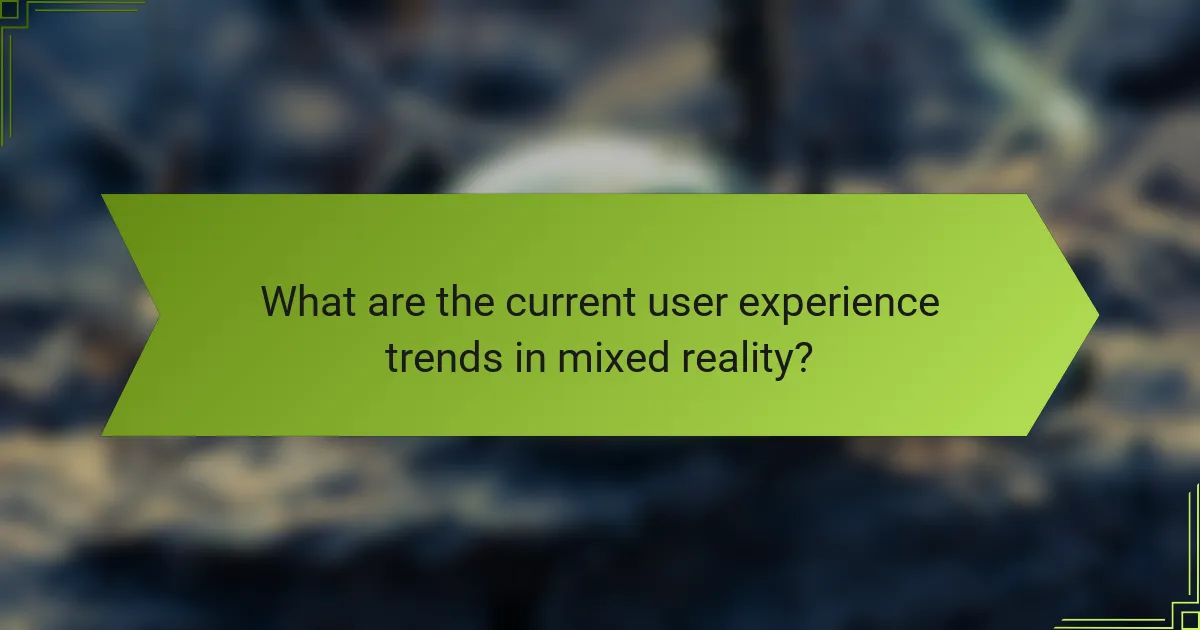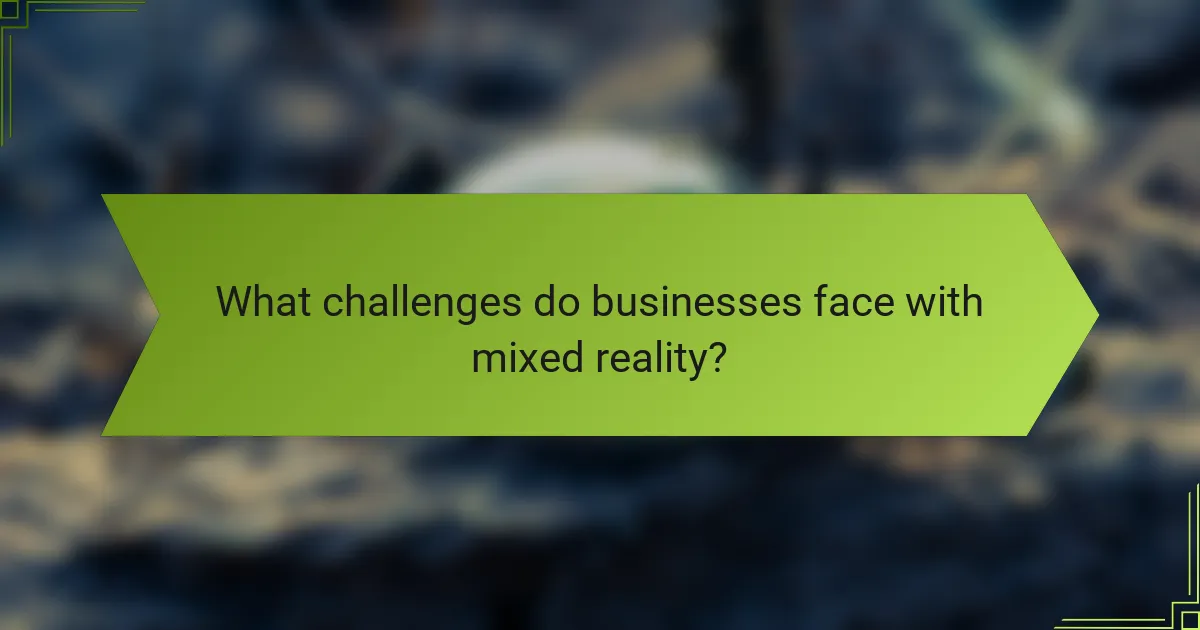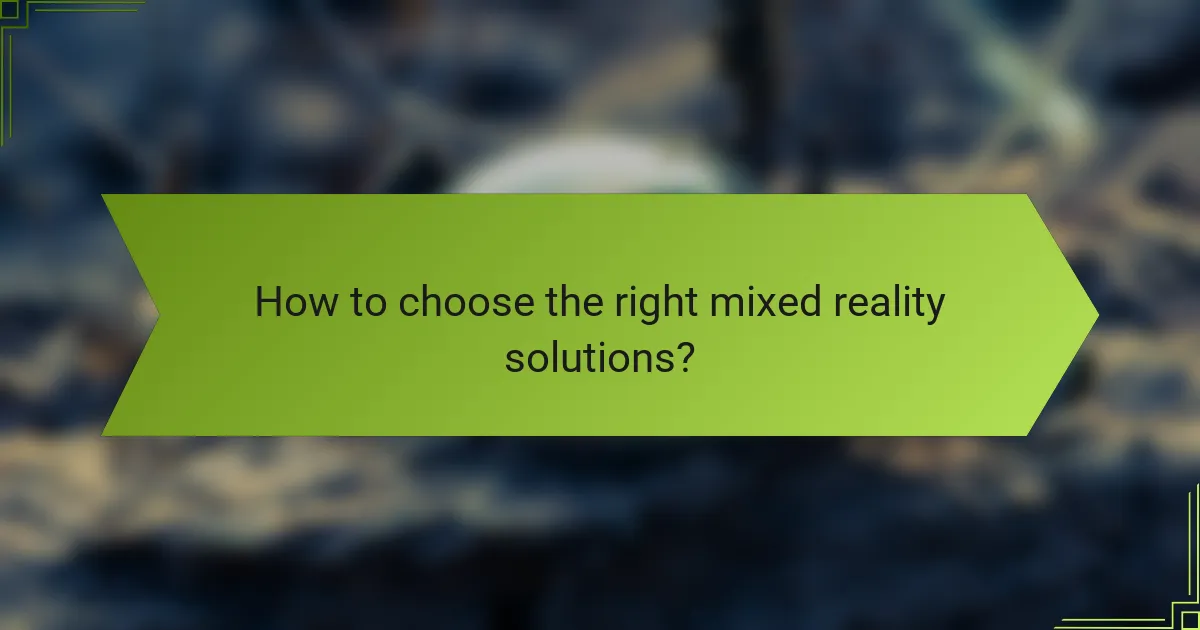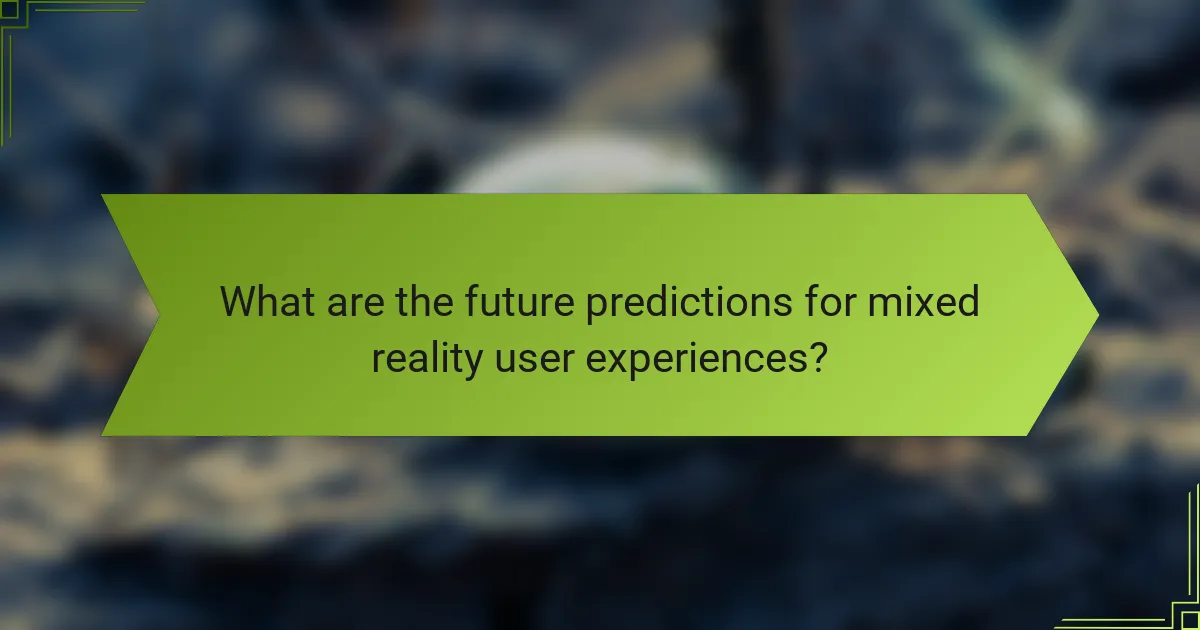User experience trends in mixed reality are rapidly evolving, focusing on immersive storytelling and personalized interactions that enhance user satisfaction. By integrating digital content with the physical world, mixed reality creates engaging applications that improve collaboration, training, and entertainment across diverse sectors. As companies embrace these innovations, the potential for more intuitive and effective user experiences continues to expand.

What are the current user experience trends in mixed reality?
Current user experience trends in mixed reality focus on creating engaging, intuitive, and personalized interactions. These trends emphasize immersive storytelling, enhanced spatial awareness, and tailored user interfaces to improve overall user satisfaction and effectiveness.
Immersive storytelling techniques
Immersive storytelling techniques in mixed reality allow users to engage with narratives in a more interactive manner. By integrating 3D environments and real-time interactions, these techniques create a sense of presence that traditional media cannot achieve.
For example, users can participate in a story by making choices that affect the outcome, enhancing emotional investment. Brands are increasingly using these techniques in marketing campaigns to create memorable experiences that resonate with audiences.
Enhanced spatial awareness features
Enhanced spatial awareness features help users navigate mixed reality environments more effectively. These features utilize spatial mapping and tracking technologies to create a seamless blend between the virtual and physical worlds.
For instance, applications can provide real-time feedback on a user’s position within a space, allowing for more natural interactions. This can be particularly useful in training simulations or gaming, where understanding the environment is crucial for success.
Personalized user interfaces
Personalized user interfaces in mixed reality adapt to individual user preferences and behaviors, making interactions more intuitive. By analyzing user data, these interfaces can present information and controls that align with a user’s habits and needs.
For example, a mixed reality application might adjust its layout based on how frequently a user accesses certain features, streamlining the experience. This personalization can significantly enhance user satisfaction and engagement, making it a key trend in the development of mixed reality applications.

How are companies implementing mixed reality innovations?
Companies are increasingly adopting mixed reality innovations to enhance user experiences across various sectors. By blending digital and physical environments, organizations can create immersive applications that improve collaboration, training, and entertainment.
Microsoft’s HoloLens applications
Microsoft’s HoloLens is a leading mixed reality device that enables users to interact with holograms in their real-world environment. Industries such as healthcare and manufacturing utilize HoloLens for training simulations, remote assistance, and design visualization.
For example, surgeons can practice complex procedures using holographic overlays, while engineers can visualize 3D models of machinery on-site. This hands-on approach facilitates better understanding and retention of information.
Meta’s Horizon Workrooms
Meta’s Horizon Workrooms is a virtual collaboration platform that leverages mixed reality to create immersive meeting spaces. Users can join from anywhere using VR headsets, allowing for real-time interaction and brainstorming in a shared digital environment.
This platform emphasizes spatial audio and customizable avatars, enhancing the feeling of presence during meetings. Companies can conduct training sessions or team-building exercises in a more engaging way compared to traditional video calls.
Niantic’s AR gaming experiences
Niantic has pioneered augmented reality gaming with titles like Pokémon GO, which encourages players to explore their surroundings while interacting with digital elements. This approach merges physical activity with gaming, creating a unique user experience.
By utilizing location-based technology, Niantic’s games promote social interaction and community engagement. Players often gather at specific landmarks for events, fostering a sense of belonging and shared experience in the real world.

What are the benefits of mixed reality for user experience?
Mixed reality (MR) enhances user experience by blending digital content with the real world, providing immersive interactions that engage users more deeply. This technology offers unique advantages across various sectors, including entertainment, education, and business, by creating more interactive and realistic environments.
Increased engagement levels
Mixed reality significantly boosts engagement levels by allowing users to interact with digital elements in a tangible way. For instance, in gaming, players can physically move and manipulate objects, which increases their emotional investment and enjoyment.
In marketing, brands can create immersive experiences where customers can visualize products in their own environment, leading to higher conversion rates. Companies that implement MR often see engagement metrics improve by substantial margins, sometimes exceeding traditional methods by over 50%.
Improved training and simulation
Mixed reality provides powerful tools for training and simulation, allowing users to practice skills in a safe, controlled environment. Industries such as healthcare and aviation utilize MR for realistic simulations, enabling trainees to experience real-life scenarios without the associated risks.
For example, medical students can perform virtual surgeries, gaining hands-on experience that enhances their learning. This method reduces training time and costs, often cutting traditional training durations by significant percentages while improving retention rates.
Enhanced collaboration opportunities
Mixed reality fosters enhanced collaboration by allowing multiple users to interact with the same digital environment, regardless of their physical location. This feature is particularly beneficial for remote teams, as it enables real-time collaboration on projects, making discussions more interactive and productive.
Tools like virtual whiteboards and 3D modeling applications allow teams to brainstorm and visualize ideas together, bridging the gap between physical and digital workspaces. Companies adopting MR for collaboration often report improved team dynamics and faster project completion times.

What challenges do businesses face with mixed reality?
Businesses encounter several challenges when implementing mixed reality (MR) technologies, including high development costs, technical limitations of devices, and user adoption barriers. Addressing these issues is crucial for successful integration and maximizing the potential of MR solutions.
High development costs
The development costs associated with mixed reality can be significant, often ranging from tens of thousands to millions of dollars, depending on the complexity of the project. This includes expenses for software development, hardware procurement, and ongoing maintenance. Companies must carefully evaluate their budgets and consider phased implementations to manage these costs effectively.
To mitigate high costs, businesses can explore partnerships with MR development firms or utilize existing platforms that offer customizable solutions. This approach can reduce initial investments while still providing access to advanced MR capabilities.
Technical limitations of devices
Current mixed reality devices often face technical limitations, such as processing power, battery life, and field of view. These constraints can hinder the user experience and restrict the types of applications that can be effectively deployed. For instance, many headsets may only support limited interaction or require frequent recharging, which can disrupt usage.
To address these limitations, businesses should stay informed about emerging technologies and consider investing in the latest hardware that offers improved performance. Regularly updating software to optimize compatibility with new devices can also enhance the overall user experience.
User adoption barriers
User adoption of mixed reality technologies can be slow due to factors like unfamiliarity, perceived complexity, and discomfort with wearing headsets. Many potential users may be hesitant to embrace MR due to concerns about usability or the learning curve associated with new technology.
To encourage adoption, businesses should provide comprehensive training and support for users, highlighting the practical benefits of MR applications. Demonstrating real-world use cases and offering trial periods can also help alleviate concerns and foster a more positive reception among users.

How to choose the right mixed reality solutions?
Choosing the right mixed reality solutions involves understanding user requirements, ensuring hardware compatibility, and evaluating software scalability. A well-informed decision can enhance user experience and maximize the effectiveness of mixed reality applications.
Assessing user needs
Start by identifying the specific needs of your users. Conduct surveys or interviews to gather insights on what features and functionalities they value most in mixed reality applications.
Consider the context in which users will engage with the technology. For instance, training simulations may require high interactivity, while entertainment applications might prioritize immersive visuals. Tailoring solutions to these needs is crucial for success.
Evaluating hardware compatibility
Ensure that the mixed reality solutions you consider are compatible with existing hardware. This includes checking the specifications of devices like headsets, sensors, and computers.
For example, if your organization uses Microsoft HoloLens, verify that your software can run efficiently on that platform. Additionally, consider the performance requirements, such as processing power and graphics capabilities, to avoid lag or subpar experiences.
Considering software scalability
Evaluate how easily the mixed reality software can scale with your organization’s growth. Look for solutions that can accommodate an increasing number of users or additional features without significant reconfiguration.
It’s beneficial to choose platforms that support modular updates, allowing you to add functionalities as needed. This approach can save costs and time in the long run, ensuring that your mixed reality solutions remain relevant and effective.

What are the future predictions for mixed reality user experiences?
Future predictions for mixed reality (MR) user experiences indicate a significant evolution in how users interact with digital content, blending the physical and virtual worlds seamlessly. Innovations in technology, particularly in artificial intelligence, retail applications, and haptic feedback, will shape these experiences over the coming years.
Integration with AI technologies
The integration of artificial intelligence (AI) into mixed reality is expected to enhance personalization and interactivity. AI can analyze user behavior and preferences in real-time, allowing MR applications to adapt dynamically to individual needs, creating a more immersive experience.
For example, AI-driven virtual assistants in MR environments can provide contextual information based on the user’s location and activities, improving navigation and decision-making. This integration will likely lead to more intuitive interfaces and smarter interactions, making MR experiences feel more natural.
Widespread adoption in retail
Mixed reality is poised for widespread adoption in the retail sector, transforming how consumers shop. Retailers will utilize MR to create interactive experiences, allowing customers to visualize products in their own environments before making a purchase.
For instance, furniture stores may offer MR applications that let users see how a sofa fits in their living room, enhancing customer satisfaction and reducing return rates. This trend will likely drive increased investment in MR technologies among retailers, aiming to improve customer engagement and sales.
Advancements in haptic feedback
Advancements in haptic feedback technology will significantly enhance mixed reality experiences by providing users with tactile sensations that mimic real-world interactions. This technology allows users to feel textures, resistance, and impacts, making virtual interactions more realistic.
For example, in gaming or training simulations, users could feel the weight of a virtual object or the impact of a virtual collision, increasing immersion. As haptic technology continues to evolve, it will play a crucial role in making MR applications more engaging and effective across various industries, from entertainment to education.
